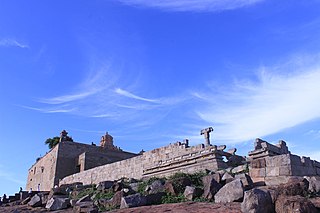
Erumbeeswarar Temple in Thiruverumbur, Tamil Nadu, India, is a Hindu temple dedicated to the deity Shiva. Built on a 60-foot (18 m) tall hill, it is accessible via a flight of steps. The temple's main shrines and its two prakarams are on top of the hill, while a hall and the temple tank are located at the foothills. Shiva is believed to have transformed himself into an ant hill and tilted his head at this place to enable ants to climb up and worship him. Erumbeeswarar is revered in the canonical 7th-century Tamil Saiva work the Tevaram, written by Tamil saint poets known as nayanmars and classified as Paadal Petra Sthalam.

Kandeeswarar Temple is a Hindu temple dedicated to the god Shiva located in Kandiyur also known as Thirukkandiyur or Tirukkandiyur, near Tiruvaiyaru, Tamil Nadu, India. Shiva is worshiped as Kandeeswarar, and is represented by the lingam and his consort Parvati is depicted as Mangalanayagi. The presiding deity is revered in the 7th-century-CE Tamil Saiva canonical work, the Tevaram, written by Tamil poet saints known as the nayanars and classified as Paadal Petra Sthalam. As per legends, Shiva is believed to have destroyed eight different demons and the eight Ashta Veeratanam temples are built signifying each of his victories in the war. The temple is one of the eight where Shiva is believed to have removed one of the five heads of Brahma.

Aiyarappar is a Hindu temple dedicated to Shiva located in the village of Tiruvaiyaru, Tamil Nadu, India. Shiva is worshiped as Aiyarappar, and is represented by the lingam and his consort Parvati is depicted as AramValarthaNaayagi. The presiding deity is revered in the 7th century Tamil Saiva canonical work, the Tevaram, written by Tamil poet saints known as the nayanars and classified as Paadal Petra Sthalam.

Sivayoginathar Temple also known as Yoganandeswarar temple is a Hindu temple dedicated to Shiva located in is located in Thiruvisanallur in Thanjavur district, Tamil Nadu, India. Shiva is worshiped as Sivayoginathar, and is represented by the lingam and his consort Parvati is depicted as Mangala Nayagi. The presiding deity is revered in the 7th century Tamil Saiva canonical work, the Tevaram, written by Tamil poet saints known as the nayanars and classified as Paadal Petra Sthalam.
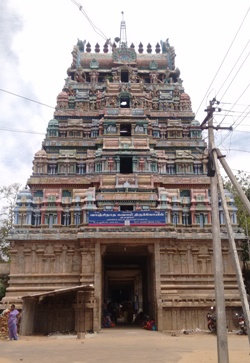
Vanchinadha Swamy temple is a Hindu temple dedicated to the deity Shiva, located in Srivanchiyam, Tiruvarur District, Tamil Nadu, India. Shiva is worshiped as Vanchinadha Swamy, and is represented by the lingam. His consort Parvati is depicted as Mangalambigai Amman. The presiding deity is revered in the 7th century Tamil Saiva canonical work, the Tevaram, written by Tamil saint poets known as the Nayanmars and classified as Paadal Petra Sthalam.
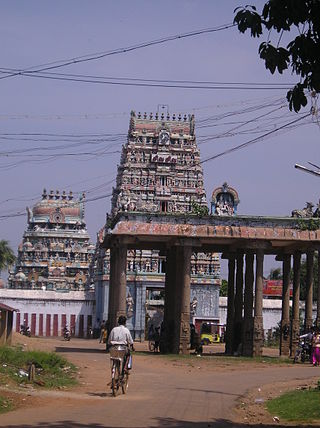
The Masilamaniswara Temple, Thirumullaivoyal or Masilamaniswara Temple is a Hindu temple dedicated to Shiva located in Thirumullaivoyal in the Chennai-Avadi road, India. The temple is incarnated by the hymns of Tevaram and is classified as Paadal Petra Sthalam. The temple is incarnated by the hymns of Sundarar, Ramalinga Swamigal and Arunagirinathar. His consort Parvati is depicted as Piraisoodi Amman. The presiding deity is revered in the 7th-century Tamil Shaiva canonical work, the Tevaram, written by Tamil saint poets known as the nayanars and classified as Paadal Petra Sthalam.

Sakshinatheswarar Temple or Thiruppurambiyam Temple is a Hindu temple dedicated to the God Shiva located in Thiruppurambiyam, Tamil Nadu, India. Shiva is worshipped as Sakshinathar, and is represented here by a Lingam. His consort, Parvati, is depicted as Ikshuvani. The presiding deity is revered in the 7th century Tamil Saiva canonical work, Thevaram, written by Tamil saint poets, known as the Nayanmaars and classified as Paadal Petra Sthalam.
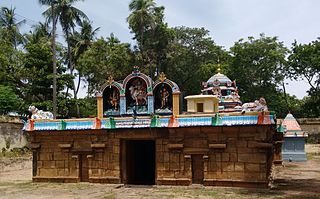
Chakramangai or Chakravageswarar Temple is a Hindu temple dedicated to Hindu deity Shiva and is located in Chakkarapalli, Papanasam taluk of Thanjavur district, Tamil Nadu, India. The temple is incarnated by the hymns of Thevaram, the 7th century Tamil literature and is classified as Paadal Petra Sthalam. It is one of the 275 Paadal Petra Sthalams, where the three of the most revered Nayanars, Appar and Tirugnana Sambandar have glorified the temple with their verses during the 7th-8th century. The temple has been widely expanded by Chola kings during the 11th century.

Pushpavananathar Temple is a Hindu temple dedicated to Shiva located in the village of Tiruppoonturutti near Tiruvaiyaru, Tamil Nadu, India. Shiva is worshiped as Aiyarappar, and is represented by the lingam and his consort Parvati is depicted as Soundaranayagi. The presiding deity is revered in the 7th-century-CE Tamil Saiva canonical work, the Tevaram, written by Tamil poet saints known as the nayanars and classified as Paadal Petra Sthalam.

Odhanavaneswarar Temple, Tiruchotruturai is a Hindu temple dedicated to Shiva located in the village of Tiruchotruthurai, Tamil Nadu, India. The Five Rivers are Vadavaru, Vennaaru, Vettaaru, Kudamuruttiyaaru and Kaaviriyaaru. Shiva is worshiped as Odhanavaneswarar, and is represented by the lingam and his consort Parvati is depicted as Annapoorani. The presiding deity is revered in the 7th century Tamil Saiva canonical work, the Tevaram, written by Tamil poet saints known as the nayanars and classified as Paadal Petra Sthalam.

Vedapuriswarar Temple, Thiruvedhikudi or Vazhaimadunathar Temple is a Hindu temple dedicated to Shiva located in Thiruvedhikudi near Tiruvaiyaru, Tamil Nadu, India. The presiding deity is revered in the 7th century Tamil Saiva canonical work, the Tevaram, written by Tamil poet saints known as the nayanars and classified as Paadal Petra Sthalam. The temple is counted as the earliest of all Chola temples.

Apathsahayar Temple, Thirupazhanam is a Hindu temple dedicated to Shiva located in Thirupazhanam near Tiruvaiyaru, Tamil Nadu, India. The presiding deity is revered in the 7th century Tamil Saiva canonical work, the Tevaram, written by Tamil poet-saints known as the nayanars and classified as Paadal Petra Sthalam. The temple is counted as the earliest of all Chola temples.

Masilamaniswara Temple is a Hindu temple dedicated to Hindu god Shiva, located in the village of Thiruvaduthurai, located 22 km from the South Indian town, Kumbakonam and 14 km from Mayiladuthurai, Tamil Nadu. It is one of the shrines of the 275 Paadal Petra Sthalams. The temple is referred to in the verses of Tevaram, the 7th century Tamil Saiva canon by Tirugnana Sambandar, Appar and Sundarar. The temple is associated with the legend of Saivite saint Tirumular.
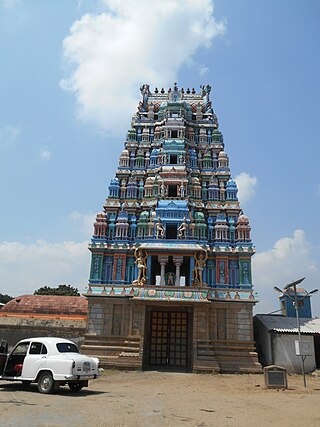
Kuzhagar Temple or Kodi Kuzhagar Temple is a Hindu temple dedicated to Shiva, located in the town of Kodikkarai in Tamil Nadu, India. Kuzhagar is revered in the 7th century Tamil Saiva canonical work, the Tevaram, written by Tamil saint poets known as the nayanars and classified as Paadal Petra Sthalam.

Chandramowleeswarar Temple, Thiruvakkarai in Thiruvakkarai, a village in Villupuram district in the South Indian state of Tamil Nadu, is dedicated to the Hindu god Shiva. Constructed in the Tamilian style of architecture, the temple is believed to have been built during the Cholas period in the 10th century. The temple has received gracious endowments from the Chola queen Sembiyan Mahadevi. Shiva is worshipped as Chandramowleeswarar and his consort Parvathi as Amirthambigai.

Kripapureeswarar Temple in Thiruvennainallur, a panchayat town in Villupuram district in the South Indian state of Tamil Nadu, is dedicated to the Hindu god Shiva. The presiding deity is revered in the 7th century Tamil Saiva canonical work, the Tevaram, written by Tamil saint poets known as the Nayanmars and classified as Paadal Petra Sthalam. The temple is closely associated with Sundarar, the saivite saint of the 8th century, who started composing his Tirumurai starting with "Pitha Piraisudi" verse in this temple.

Agnipureeswarar Temple in Thirupugalur, a village in Nagapattinam district in the South Indian state of Tamil Nadu, is dedicated to the Hindu god Shiva. Constructed in the Tamil style of architecture, the temple is believed to have been built during the Cholas period in the 10th century. Shiva is worshipped as Agnipureeswarar and his consort Parvathi as Karundar Kuzhali. The temple is believed to be the place where Saiva saint Appar is believed to have attained salvation.
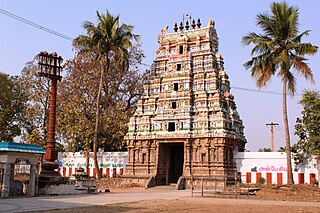
Bhaktajaneswarar Temple is a Hindu temple dedicated to the deity Shiva, located in Thirunavalur, a village in Viluppuram district in the South Indian state of Tamil Nadu. Shiva is worshipped as Bhaktajaneswarar, and is represented by the lingam. His consort Parvati is depicted as Manonmani Amman. The temple is located on the Panruti - Kedilam road. The presiding deity is revered in the 7th century Tamil Saiva canonical work, the Tevaram, written by Tamil saint poets known as the nayanmars and classified as Paadal Petra Sthalam. The temple is closely associated with Sundarar, who is believed to have attained grace at this place.

Pushpavaneswarar temple in Thirupuvanam, a town in Sivaganga district in the South Indian state of Tamil Nadu, is dedicated to the Hindu god Shiva. Constructed in the Dravidian style of architecture, the temple is believed to have been built during the Cholas period in the 7th century. Shiva is worshipped as Pushpavaneswarar and his consort Parvathi as Soundaranayagi.

Kapardeeswarar temple is a Hindu temple situated in the village of Thiruvalanchuzhi near Swamimalai in Kumbakonam taluk of Thanjavur district, Tamil Nadu, India. Shiva is worshiped as Kapardeeswarar and is represented by the lingam and his consort Parvati is depicted as Brihannayagi. The presiding deity is revered in the 7th century Tamil Saiva canonical work, the Tevaram, written by Tamil poet saints known as the nayanars and classified as Paadal Petra Sthalam.



























